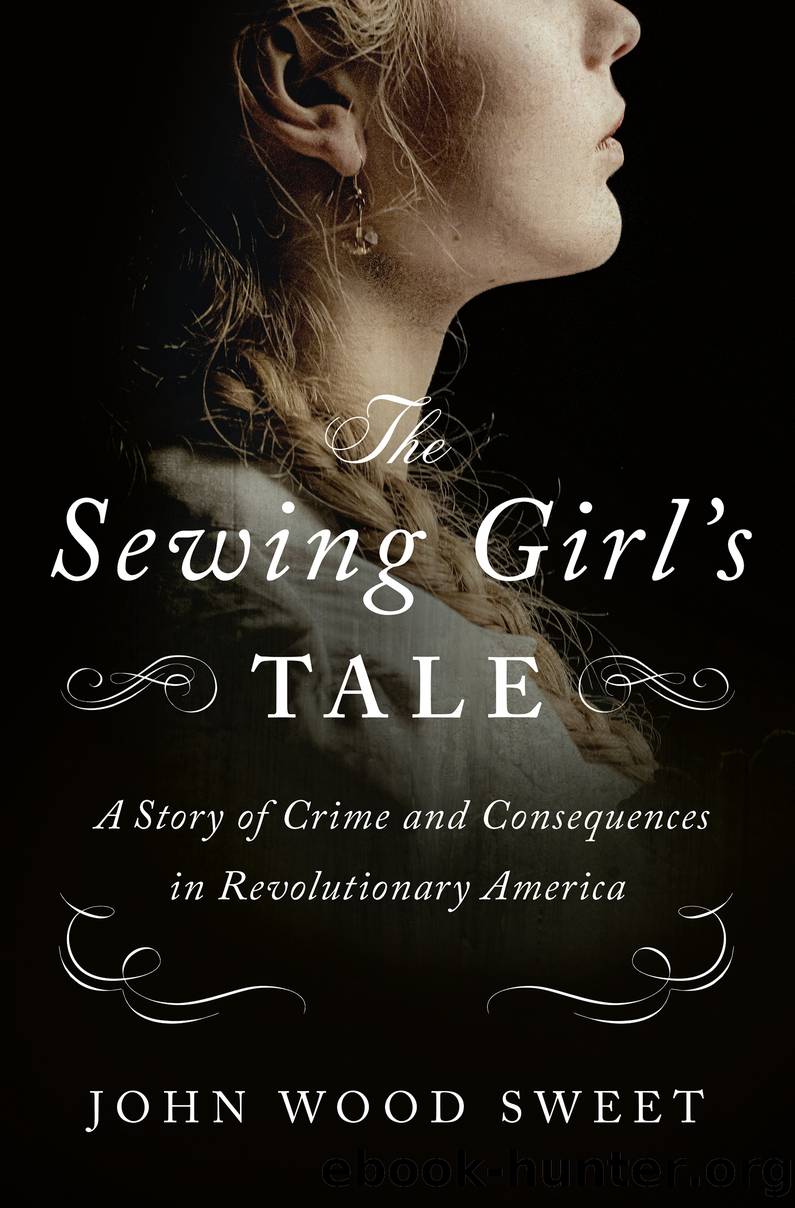The Sewing Girl's Tale by John Wood Sweet

Author:John Wood Sweet
Language: eng
Format: epub
Publisher: Henry Holt and Co.
* * *
68 BROADWAY, NEW YORK. WEDNESDAY, OCTOBER 16, 1793. BEFORE 9 P.M.
Women, too, were shocked and disturbed by the Bedlow trialâand they, too, struggled to make their voices heard. A few days after the trial, the forty-six-year-old defense attorney Richard Harison decamped for Albany, leaving his twenty-seven-year-old wife, Frances, in charge of their imposing town house on Broadway, her teenaged stepchildren, her own young daughter, her aged mother-in-law, and a staff of servants that included at least two free people of color and two enslaved people. In his absence, she was besieged by ugly gossip about the trialâand then came the riots. By Wednesday, she was upset enough to write her much older husband an uncharacteristically forceful letter.
A fashionable dresser with an abundance of curly auburn hair, a long face, and penetrating blue eyes, Frances Harison typically filled her letters to her husband with affection, deference, and self-deprecating humor. She would ask for advice about minor business matters and report on her endless rounds of social visits, including sewing circles at which she and her friends sat âat our workâ while âchattering about Furniture, Politics, [Dances], and Deaths.â But, in the aftermath of the Bedlow trial, their âchatterâ was neither idle nor amusing. With her cousin Edmund Ludlow also facing rape charges that fall, it was hard not to take reaction to the Bedlow trial personally. And members of her social circle were shocked by what they had seen and heard about the trialâparticularly, it seems, about the defense teamâs tactics. Shamed by the gossip about her husband and shaken by the two nights of street protests, she sat down to compose a letter to him about the riots and what their friends had been saying. Frances Harison was clearly anxious about the letterâs implied criticism of her husbandâs professional conductâand for good reason.
Richard Harison didnât keep his wifeâs letter, but she kept his responseâwhich began by acknowledging that she had been âtruly frightenedâ by the riots, which he went on to ridicule before dismissing everything else she had written. âI could hardly refrain from laughing,â he wrote, at your âtragicomical Description of the Mob,â the dragoons, and âthe vast Effusion of Feathers.â For Harison, the rioters were nothing more than members of âan uninformed & unsteady Populace.â Even so, he was aware that the trial had been uglyâand that Bedlow wasnât exactly innocent. It was his professional duty to defend his client to the best of his ability, Harison explained, âwhatever might be the Indecency of the Trial, or the Criminality of the Prisoner.â Nonetheless, he went on, âI have not disgraced myself by uttering a Sentiment favorable to Vice, or occasioning a Blush in the Cheek of Modesty, which could possibly be avoided.â This rebuke, it seems, had the desired effect; a week later, he wrote back to accept his wifeâs apology.
This was pretty much the response Abigail Adams had gotten to her 1776 letter asking her husband to remember the ladies. John Adams treated his âsaucyâ wifeâs letter as a joke.
Download
This site does not store any files on its server. We only index and link to content provided by other sites. Please contact the content providers to delete copyright contents if any and email us, we'll remove relevant links or contents immediately.
2010-The City & the City by China Miéville(1961)
Anatomy of Injustice by Raymond Bonner(1643)
That Every Man Be Armed by Stephen P. Halbrook(1563)
ADHD on Trial by Michael Gordon(1553)
Injustices by Ian Millhiser(1479)
You Don't Own Me by Orly Lobel(1424)
Tell by Major Margaret Witt(1415)
Course Correction by Ginny Gilder(1392)
Broken Scales by Joel Cohen(1338)
Without Copyrights by Spoo Robert(1334)
A Vast Conspiracy by Jeffrey Toobin(1310)
First by Evan Thomas(1269)
A Religious Orgy in Tennessee by H.L. Mencken(1236)
J by Howard Jacobson(1234)
The Run of His Life: The People v. O. J. Simpson by Jeffrey Toobin(1190)
A Triumph of Genius: Edwin Land, Polaroid, and the Kodak Patent War by Ronald K. Fierstein(1186)
A History Of Thailand by Baker Chris(1164)
John Wayne Gacy by Judge Sam Amirante(1090)
Law 101: Everything You Need to Know About American Law, Fourth Edition by Jay Feinman(1075)
